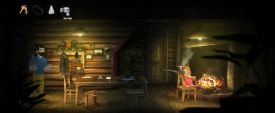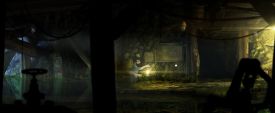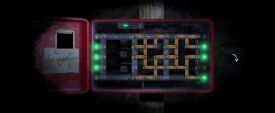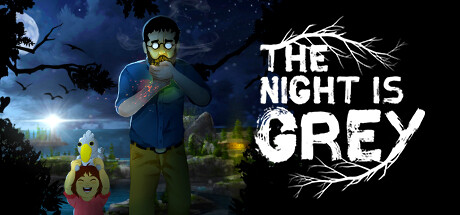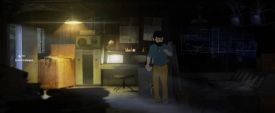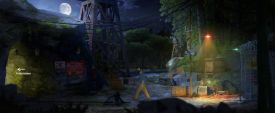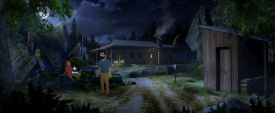|
By flotsam
The Night is Grey
Whalestork Interaction
This is a thrilling piece of
cinematic storytelling.
Graham is alone in a forest,
pursued by wolves and looking for sanctuary. Instead he finds Hannah, a
small girl similarly alone, and pointing a gun at him. So begins their
relationship, one that will take them through abandoned mines, a
scientific research facility and the ever-present forest in order to get
to Hannahís grandparent's house. All sorts of obstacles must be
overcome, from locked gates to personal demons. And of course the
wolves.
There is a dark undercurrent
that accompanies their efforts, and which reveals more of itself as the
game goes along. It is apparent from the very first Ďnarration,' three
little written statements that unfold on a black screen to the sound of
trickling water followed by heavy breathing, running footsteps and
Graham bursting from left of screen. If he thought he could out-run the
written word he is mistaken; each new chapter starts with a similar
berating.
It would tell you too much to
tell you too much more about the tale. Suffice to say that it is
superbly written, smoulders as it unfolds, and will surprise you more
than once. Itís an exercise in juxtapositions; straightforward but not,
eerie and mundane, red herrings and real ones. As I write this, 24 hours
after having finished, I am still reflecting on it, piecing its bits
together, contemplating its construction. Like every good thriller, I
canít wait to revisit certain aspects to see what was there to be seen
that I might have missed or perhaps have interpreted differently.
Equally as wonderful as the
writing is the visual design. A combination of hand drawn characters and
digitally animated backgrounds, it is a sumptuous treat. They come
together to produce a layered depth beyond the 2D, and despite the
screens being largely static there is a rich and detailed real world
feel to the whole thing.
That is helped by the little
things; dust motes swirling in the foreground, the use of light and
shadow, the sea lapping the shore in the background. Ditto the cinematic
zooming in and out that might accompany a screen change or a change in
location
Plus the sound. There is no
spoken word, although there are sound effects for much of what the
characters do (cough, whistle, pant, etc). Ambient sound is heavily
present throughout, and the soundtrack (whilst a tad repetitive) adds
the appropriate tension and frisson to the particular circumstances.
I didnít miss the lack of spoken
word, although I would have preferred not to have had to click to
advance the dialogue. I like hearing voices, but when it's written I can
decide how the character sounds, and there is no let-down as a result.
Graham sounded just like Graham would have sounded, as did all the
others, so I was well pleased.
Graham plays a central role, and
his characterisation deserves mentioning. Again, to avoid telling you to
much, his personal journey is reflected in everything about him; his
mannerisms, his introspection, even the puzzling. Get him to talk to
himself to reveal more about him.
The Night is Grey is classic
point-and-click. Everything is done with the mouse, save for the reveal
all hotspots which is the spacebar. Left click to interact, right click
to look, click to move here, click to use inventory items in the game
world yada yada yada. You know the drill.
Much of the puzzling is
inventory based (i.e., find and use the right item/s) but there are more
than a few others that will exercise your powers of observation,
attention and deduction. Spatial recognition and maths are but two
aptitudes to deploy, along with good old fashioned trial and error. I
thought all of them were fair in the sense that I knew what they wanted
from me; whether I could provide it was the thing. The in-puzzle hint
system helped more than once, and yet never gave away the answer (at
least not when I used it).
You can Ďdie,' but you can pick
up at your last save (or the autosave which probably isnít too far
away). I was surprised the first time that happened, even more so by
what came along with it.
There is also a maze, in which
you can also die. I tend to think of mazes as largely lazy filler, but
this is the second game in a row where I rather enjoyed the experience.
There is a map, which helps more once you work out the mechanics of the
maze, which might require you to die once or twice. From that point on I
wanted to map it to solve it, but you might think differently.
Looking at stuff and conversing
with others can be key to triggering a progression so make sure you do
that. Much of what you look at is also there to provide depth, as are
the conversations you might have, and more than a lot of games I would
err on the side of doing all of that. Hotspots are generous, and with
the spacebar option you wonít miss a thing.
You will find an array of
documents, and there is important information contained within. These
can all be re-examined at any time, although you will need to utilise
the extras menu to do so. That same menu has an emerging game map as
well as concept art, neither of which you need within the game.
To complete the puzzling
discussion, there are a few short sequences where you have to click at
the right time in order to progress. I didnít think they were hard,
although I am aware some players found them frustrating. But given the
nature of the rest of the game I actually donít see the point of them. I
donít think they added anything apart from the aforementioned possible
frustration.
The game saves automatically but
you can also save at will. There is a single autosave and I would
suggest saving at least at the start of every chapter should you want to
dive back in at the end. Plus as many other save points as you desire.
Many screens scroll sideways,
and a short load accompanies each exit point. Graham doesnít run, but
clicking the arrow which indicates an exit point will jump him to that
next screen.
In conclusion, this game is
top-notch. The quibbles are merely that, the strengths so much more, and
the game as a whole warrants your attention.
I played on:
OS: Windows
10, 64 Bit
Processor:
Intel i7-9700K 3.7GHz
RAM: Corsair
Dominator Platinum RGB DDR4 32GB
Video card:
AMD Radeon RX 580 8192MB
GameBoomers Review Guidelines
March 2024
design copyright© 2024
GameBoomers
Group
 GB
Reviews Index GB
Reviews Index |
